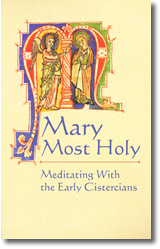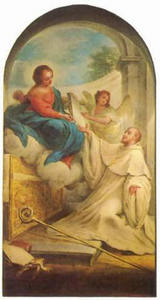O Clemens, O Pia, O Dulcis, Virgo Maria
 Allow me to recommend a book for the month of May: Mary Most Holy, Meditating With the Early Cistercians, edited by E. Rozanne Elder, Cistercian Publications, Kalamazoo, 2003. Dr. Elder presents Marian texts of the twelfth and thirteenth century drawn from thirteen Cistercian authors: Adam of Perseigne, Aelred of Rievaulx, Amadeus of Lausanne, Baldwin of Forde, Bernard of Clairvaux, Geoffrey of Auxerre, Gertrude the Great of Helfta, Gilbert of Hoyland, Guerric of Igny, Isaac of Stella, John of Forde, Stephen of Sawley, and William of Saint–Thierry. Along the same lines, I should like to add my own (rather limited) presentation of devotion to the Blessed Virgin Mary in Cistercian tradition and practice. If any one thing drew me to Cistercian branch of the great Benedictine family, it was its cherished tradition of love for Mary.
Allow me to recommend a book for the month of May: Mary Most Holy, Meditating With the Early Cistercians, edited by E. Rozanne Elder, Cistercian Publications, Kalamazoo, 2003. Dr. Elder presents Marian texts of the twelfth and thirteenth century drawn from thirteen Cistercian authors: Adam of Perseigne, Aelred of Rievaulx, Amadeus of Lausanne, Baldwin of Forde, Bernard of Clairvaux, Geoffrey of Auxerre, Gertrude the Great of Helfta, Gilbert of Hoyland, Guerric of Igny, Isaac of Stella, John of Forde, Stephen of Sawley, and William of Saint–Thierry. Along the same lines, I should like to add my own (rather limited) presentation of devotion to the Blessed Virgin Mary in Cistercian tradition and practice. If any one thing drew me to Cistercian branch of the great Benedictine family, it was its cherished tradition of love for Mary.
Saint Bernard, Citharista Mariae
Cistercian devotion to the Blessed Virgin Mary is at once strong and tender. It is lyrical — is not our Saint Bernard, the Abbot of Clairvaux, called the Citharista Mariae, Mary’s Player of the Lyre? Cistercian devotion to the Blessed Virgin Mary is also quotidian — finely woven into the fabric of every hour of every day.
The Holy Name of Mary, Virgin and Mother
At the beginning of the Order, the Blessed Virgin Mary, Queen of heaven and earth was declared for all time the Lady and Protectress of each of its monasteries. To this day, every Cistercian monastery bears a title of the Blessed Virgin and celebrates her glorious patronage on August 15th, the Solemnity of the Assumption. In 1335 the Cistercian General Chapter decreed that the seal of each abbey should bear the image of the Blessed Virgin Mary. She is The Lady of the monastery: mother, sovereign, advocate, and protectress. This corporate dedication to the Mother of God is personalized by the custom of conferring upon every monk and nun of the Order at the time of his or her clothing in the habit, the sweet name of Maria.

The White Cuculla
The white Cistercian choir habit — the cuculla or cowl — honours the purity of the Blessed Virgin Mary and the glory that is hers in the mystery of the Assumption where she is seated next to her risen and ascended Son. The white cowl is a sign of her protection, rather like the scapular of the Carmelites. When the Cistercian monk puts on his cowl before going to choir to sing the praises of God, he is, symbolically, clothing himself in the virtues of the Blessed Virgin Mary, his Mother.
In the Sacred Liturgy
In every Cistercian monastery the festivals of the Blessed Virgin Mary are celebrated with a gladsome solemnity. The Cistercian liturgical calendar further elevates to the rank of solemnity days which the Roman calendar keeps with the rank of feast: February 2nd, the Presentation of the Lord/Purification of the Blessed Virgin Mary; May 31st, the Visitation; and September 8th, the Nativity. For Cistercians, the highest Marian festival is the glorious Pasch of Summer, the Assumption of the Blessed Virgin Mary on August 15th. Much of the Office on that day is drawn from the sublime poetry of the Canticle of Canticles.
Until the liturgical upheavals that followed the Second Vatican Council, it was customary to provide for a daily celebration of the Mass De Beata (in honour of the Blessed Virgin Mary) and to chant the Little Office of the Blessed Virgin Mary daily in choir, alongside the Canonical Hours of the Great Office. The present practice is to sing an antiphon in honour of the Blessed Virgin Mary at each of the Hours of the Divine Office. At every liturgical Hour Cistercians the world over praise the Blessed Virgin and seek her intercession. Individual monks and nuns may, of course, continue to pray the Little Office of the Blessed Virgin Mary on their own in addition to the Divine Office in choir.
The Salve Regina
The Cistercian day ends with the solemn singing of the Salve Regina in a darkened church. Two candles illumine the image of the Mother of God: the life, sweetness, and hope of her children. According to tradition, the last three cries of the Salve  Regina — O clemens! O pia! O dulcis Virgo Maria! — were added by Saint Bernard himself in a rapture of love for the Mother of Christ.
Regina — O clemens! O pia! O dulcis Virgo Maria! — were added by Saint Bernard himself in a rapture of love for the Mother of Christ.
The Rosary
One last note: the roots of Mary’s Psalter, the Holy Rosary, lie deep in Cistercian soil. In his book entitled, Louange des mystères du Christ: histoire du rosaire, Dr. Andreas Heinz of the Theological Faculty of Trier, presents the pre–history of the Rosary in its native Cistercian context. Already in the twelfth century, Cistercian monks were meditating the mysteries of Christ and of His Virgin Mother while repeating the Angelic Salutation, the Ave Maria. For five centuries the Rosary was a work in progress; it began in the silence of Cistercian (and Carthusian) cloisters before being popularized by the Order of Preachers. For the early Cistercians the meditation of the mysteries of our Lord and of His Mother was a kind of lectio divina, a way of extending the influence of the Sacred Liturgy and of holding its treasures in the secret of one’s heart.

Thank you, Fr. Mark for this.Meditating upon the mysteries of the most holy Rosary,imitating what they contain and obtaining what they promise can be a long hard struggle through the joyful, through the sorrowful but then always, always and forever into the glorious.
I hope that you do not mind if I throw a few obervations into the mix.
I have a strong conviction that one of the deepest crises for monastic life is a certain Marian crisis. Yes, many customs and traditions are kept but they are often seen by the monks themselves as devotional, and not reflecting the essential part Mary plays in the mystery of Christ and the church.
This flight from woman and even a certain fear of the feminine is part of our age and a source of so much pain. Women have made advance with social and civil liberties, but I think Karl Stern made a great case for modern man’s restless flight from the feminine in his classic work ‘THE FLIGHT FROM WOMAN’.
It is only when a person is really rooted in the feminine that s/he is truly “at home” and can be a source of fruitfulness. Without this inner stability, we are always restless and just running from program to program. Without this inner stability, our alienation increases, the restlessness becomes more compulsive and now with all that technology can provide the crisis only deepens.
Three poems that I have found very helpful to grasp this insight are: “Prayer to the Virgin of Chartres” by Adams; “The Virgin Mary compared to air we breath” by Hopkins; and a prose poem by Thomas Merton “Hagia Sophia”. Each express in their own way the authors’ deep encounter with the mystery of Mary.
Perhaps the one who really knew this secret and opens the mystery for us all, monk, cleric or lay is Louis de Montfort. There is an excellent book out on St Louis that one can order from the biblicum in rome that is very helpful in learning the depths of Montfort’s teaching.
http://www.unigre.it/Tg/spiritualita10.htm
You are absolutely right, Patrick. In one of our monasteries, blessed with both many vocations and a high level of perseverance, the secret was that all the monks practiced the substance of Saint Louis Marie de Montfort’s True Devotion. The postulants were guided into making a total consecration to Mary before beginning the novitiate. Saint de Montfort takes the teaching of Saint Bernard, of Bl. Guerric, and of our other twelfth century fathers, synthesizes it, and gives it a practical appplication.
Thanks to Patrick’s suggestion, I have now found a link that has 26 of Thomas Merton’s Marian poems…a lot of poetry! The quickening of St. John the Baptist, written in 1949, is certainly one I will return to later..there is such choice.
See The Cistercian Studies Quarterly 33/2 (1998). The issue on “Citeaux and Devotion to Mary,” contains several outstanding articles: “Mary and the Monk,” by Augustine Roberts; “Cistercian Antecedents of the Rosary,” by Andre Fracheboud; and “Mary, Mediatrix of all Graces, in the Work of Adam of Perseigne,” by Bishop Kazimierz Romaniuk.
Cistercian Studies Quarterly
O. L. of the Mississippi Abbey
8400 Abbey Hill
Dubuque, IA 52003 csq@mississippiabbey.org
Fax: 563-582-5511
Don Marco, Which monastery are you indicating when you say “In one of our monasteries, blessed with both many vocations and a high level of perseverance”? I am curious to know and I wonder if the other monks have so dedicated themselves to the BVM in this manner.
Thanks for the resources. What is the text for one’s total consecration a la Monfort?
Thanks for this post. Now I realize another connection I can make with the Cistercians: the festival of the Assumption. This liturgical obervance is my most favorite of Marian feasts with the fast prior, the poetry, the hymns and preaching. (I even artistically incorporated the Solemnity of the Assumption in my stemma.)
You mention that a Cistercian day concludes with the Salve Regina. True, but when was this tradition picked up by the OSB? I’ve never known the black Benedictines not to conclude the Compline office with a Salve or some Marian hymn, though may be because of the OCist influence.
Do you know if Dr. Andreas Heinz’s book has been translated into other languages like English?
Patrick: Thanks for the book suggestion. I purchased THELAGATHOTI JOSEPH RAJA RAO’s book today.
PAX
Dear Neri, I hope I’m not being indiscrete in saying it, but the monastery to which I referred was the Abbey of Lérins in France. About twenty–five years ago when Père Marie–Joseph (now deceased)was Master of Novices, he directed all the postulants in preparing for total consecration to Mary according to the teachings of Saint Louis de Montfort. His efforts bore lasting fruit. I’m sure that the same practice was followed in other monasteries of our Order too. Saint Louis de Montfort relies heavily on Saint Bernard and has a certain affinity with the Cistercian tradition.
Neri, in answer to your last question, read “True Devotion to Blessed Virgin Mary” by Saint Louis de Montfort or the abridged version entitled “The Secret of Mary.”
Carissimo PAZ, I don’t think that Dr. Heinz’s book has been translated into English but there was an article on the same subject by Dom André Fracheboud in Cistercian Studies back in the 90s if I am not mistaken. There was a special issue on Mary and Cistercian Life. It should still be available.
PAZ, Ordering info and phone number for getting that issue of Cistercian Studies:
Cistercian Studies Quarterly
O. L. of the Mississippi Abbey
8400 Abbey Hill
Dubuque, IA 52003
csq@mississippiabbey.org
Fax: 563-582-5511
Order one for me, please, while you’re at it. Thanks.
This is good news to hear of the monastery in France. I have a “half baked” theory, that true marian life was more implicit in the early monastic life. Yes, they had many marian devotions, but the real marian mystery/secret was more implicit and something that was “caught” from the life style, the art and even the architecture of the buildings of monastic life.
A few years ago i was able to send some time at chartres cathedral and after a few weeks of just walking and praying in the cathedral everyday, a whole new dimension of the marian life just opened up and i remember telling a trappist friend that every cistercian should spend some weeks in a real gothic cathedral and they would find a whole new depth to St Bernard’s marian teaching.
In our more modern times, it seems to have been the mission of St Louis de Montfort to make this implicit teaching not just more conscious but to show it is rooted in the baptismal consecration of all in the maria/ecclesia. he also showed that real marian devotion must be in the context of a real I – Thou relationship and not just a part of a cultural dynamic.
But like i said it is only a theory that comes to mind!
Paz,
i found Fr. Rao’s book very interesting and insightful, i would be interested in how you find it. the montfort father’s also published JESUS LIVING IN MARY, which contains essays on montfort’s teachings by leading marian scholars.
Patrick: I wonder if we could have a discussion on Vultus Christi regarding this book of Fr Rao’s.
How did you come across this work? Has anyone reviewed it? Is it used in theology classes or other study groups?
Here in Connecticut the Monfort Fathers have their shrine dedicated to OL of Lourdes. And you know, I’ve never been. The shrine and work of the Fathers gets little play around here. Around the feast of Saint Louis Montfort EWTN showed the film produce by the Montfort Fathers on their saintly founder. I was impressed since I am unfamiliar with his life and work.
The comment about the connection with Baptism is made in the film mentioned above.
In fact, I was intrigued that Pope John Paul made Montfort’s liturgical memorial universal. Hmmmm.
Paz, i would be happy to discuss the book with you but think it would be more appropriate and easier to do it off the site, so please email me it you wish: anthonyhouseny@aol.com